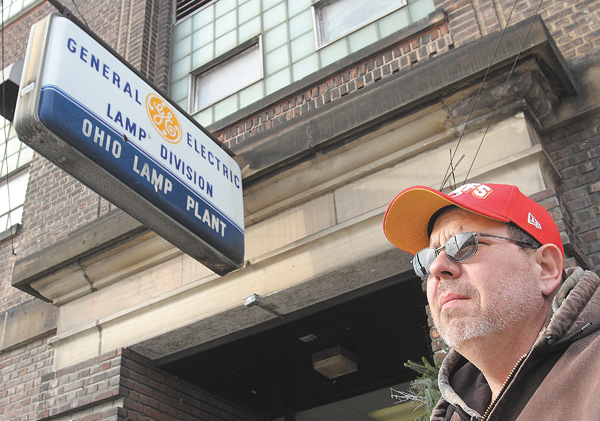Lights out in Warren at GE lamp plant


Outside the facility Thursday afternoon, Bill Chachko, a 34-year General Electric Ohio Lamp Plant employee from Hartford Township, called the plant’s closing “a tragedy,” noting at age 54 he’s planning to retrain as a machinist.
By Ed Runyan
WARREN
The closing of the General Electric Ohio Lamp Plant marks the end of a profound relationship between Warren and the incandescent light bulb.
For 85 workers leaving their jobs for the final time today at the 123-year-old GE plant on North Park Avenue, it’s difficult for many to put out of their minds that they were a handful of votes away from still having a job.
Employees interviewed by The Vindicator on Thursday mentioned the vote last March, in which 91 workers voted against a concessionary contract that would have kept the plant open. Eighty-five voted for it.
Bill Chachko, a 34-year Ohio Lamp employee from Hartford Township, called the plant’s closing “a tragedy,” adding: “It should never have happened, and if the vote would have happened today, it would be different.”
Chachko, 54, says he’s planning to retrain as a machinist.
“Eighty-five families are losing out on a job,” said one woman, referring to those who voted for the contract. Her family is losing two jobs because her husband also worked here. “We would have been here another 20 years,” she said of the plant, where 11 workers will stay on for a couple of months, removing equipment that will be taken to other GE plants.
The knowledge that the company was willing to bring new products to the plant and keep it open in exchange for concessions has made the past nine months “so stressful” inside the plant because of the divide between the workers who voted for the contract and those who voted against it, she said.
The company has not decided what it will do with the factory when the final GE workers leave, said Alicia Gauer, spokeswoman for GE Lighting.
Gauer said the building, at the corner of North Park and Dana streets, was built in 1890 by William D. Packard and James W. Packard, who started Packard Electric in 1890 and built the first Packard automobile in 1899 at that location.
Packard Electric started out manufacturing incandescent light bulbs. By 1899, it also had built the first Packard automobiles “in a corner” of the Packard Electric light-bulb building at the site of the current Ohio Lamp Plant, said Charles Ohlin of the National Packard Museum of Warren.
That building is now gone, but it’s unknown when it was removed, Ohlin said.
The brothers sold their Packard Motor Car Co. in 1902 and began Packard Electric’s focus on the wiring business, selling it to National Electric Lamp in 1902, according to a Packard Electric history published by the company in 1990.
GE purchased the light-bulb business from National Electric in about 1916. Meanwhile, Packard Electric’s wiring business grew dramatically on Dana and Griswold streets, where it established its world headquarters, then expanded along North River Road in Howland and Bazetta townships until it employed 11,000 people by 1974.
A 1898 newspaper article says the Packard brothers’ light-bulb company, called the New York and Ohio Co., was the first light-bulb businesses in the United States and the second-largest one in the country at the time.
Warren had the distinction of being the first town in America to light its streets with incandescent light bulbs in 1911, because of the Packard brothers, the National Packard Museum says.
In recent years, the Ohio Lamp Plant was the last GE plant in the United States that made only incandescent light bulbs.
There were 179 members of International Electrical Workers/Communication Workers of America Local 722 at the Ohio Lamp Plant last March, when the vote was taken. There were about 200 workers altogether, counting nonunion employees.
Truck driver Robert Moore of Youngstown, who worked at the plant 15 years, said he thinks the union “lost sight of what unions are really about” when it voted against the contract, referring to those who were willing to give up the jobs rather than accept concessions.
“You’ve got a standard of living, but how will you replace it? With two jobs? Then your kids will suffer,” Moore said. Workers made between $22 and $30 per hour, he said.
“What hurts me is the single moms that are losing health insurance,” he said.
The company announced a year ago that the plant would close, but the union had reached a tentative agreement with the company that would have involved bringing a new product to the plant.
“We’re going to be transferring some of that old equipment out and transferring in new technology as part of the plan to make energy-efficient bulbs,” IUE/CWA Local 722 President Scott Moore said last year before the vote.
“I’ve been here 33 years. I will miss the people,” Freddie Harris of Warren said. “Most of all, they’re like a family to me. I’m going to miss the job, but it is what it is. I wish them all good luck.”
Lynn McNeal of Warren, who has worked at the plant since 1976, said she is grateful for the many years she and the others had jobs at the plant, saying there were many predictions that the plant would close, even when she first got hired 37 years ago.
“Loss of jobs is not good — for us or for the Valley, but I am grateful that [God] allowed me to stay there this long. It’s been truly a blessing for all of us.”
 43
43
